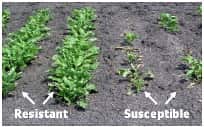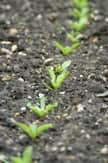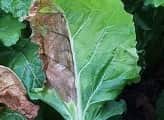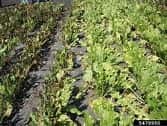Spring Review of Sugarbeet Variety Selection
The official day of spring for 2020 began on March 19th but has been slow to arrive for many in the
upper plains. For sugar beet growers in the Red River Valley and beyond, the majority are waiting for
warmer temperatures and drier conditions before field work can begin. Also, for many, beet seed varieties
were selected back in November and December of 2019. Since that time, several weather-driven factors may
have created last minute changes to rotation, field selection and planting dates. One of the most important
criteria for selecting beet seed varieties are the various disease traits by variety.
Official variety trials are important for evaluating the top performing varieties in quality and
performance, but remember these results are managed under fairly ideal conditions with intensive
disease and pest management treatments to measure genetic potential for sugar per acre and sugar per ton.
These quality ratings are great to narrow down your variety lineup decision, but disease ratings within in
your selected group and  how these traits match up to your individual needs by field will ultimately
impact your success.
how these traits match up to your individual needs by field will ultimately
impact your success.
The four major disease and pest traits that need to be considered are rhizomania, Aphanomyces, Rhizoctonia,
Fusarium, Cercospora Leaf Spot and root aphid. Rhizomania is now often overlooked as all varieties
have some level of tolerance. But it is important to note that not all varieties provide tolerance to
multiple strains of rhizomania and should be the first step in your decision process.
Remember that rhizomania can only be managed through genetics, and  resistant-breaking strains are ever
present. Soil movement and water are major components in the spread of rhizomania.
Thus, confirm your varieties have tolerance to multiple strains in order to capture the total
potential of other disease, pest and quality traits.
resistant-breaking strains are ever
present. Soil movement and water are major components in the spread of rhizomania.
Thus, confirm your varieties have tolerance to multiple strains in order to capture the total
potential of other disease, pest and quality traits.
Several established and new seed treatments in combination with both in-furrow and post application
fungicides are available for Aphanomyces and Rhizoctonia control in sugar beets.
But it’s important to remember that these treatments need to be used to
 complement disease ratings
for varieties. Seed treatments and in-furrow applications provide disease control early in the
sugar beet seedling growth stage when genetic tolerance is not yet expressed. After approximately four weeks,
these treatments cannot be relied on and the genetic tolerance is now the key factor to surviving potential
disease pressure. The disease pressure can best be summarized by evaluating disease history, previous
host crops, rotation, lime applications, environmental conditions and potential planting dates.
Early planting in cooler soils tends to minimize Aphanomyces and Rhizoctonia impact to seedlings,
as these diseases thrive under warm and moist conditions. Seed treatments are key to bridge the time
gap between seedling susceptibility to the required genetic tolerance to these diseases.
complement disease ratings
for varieties. Seed treatments and in-furrow applications provide disease control early in the
sugar beet seedling growth stage when genetic tolerance is not yet expressed. After approximately four weeks,
these treatments cannot be relied on and the genetic tolerance is now the key factor to surviving potential
disease pressure. The disease pressure can best be summarized by evaluating disease history, previous
host crops, rotation, lime applications, environmental conditions and potential planting dates.
Early planting in cooler soils tends to minimize Aphanomyces and Rhizoctonia impact to seedlings,
as these diseases thrive under warm and moist conditions. Seed treatments are key to bridge the time
gap between seedling susceptibility to the required genetic tolerance to these diseases.
Fusarium in sugar beets continues to spread and the only
 economical means of control is genetics.
Once you identify Fusarium in your actively growing fields, control is too late. As growers,
if you have begun to notice half-leaf yellowing or necrotic symptoms in previous years, there is potential of increasing pressure and the need to screen varieties. Several varieties offered have good levels of Fusarium tolerance in combinations of the other disease traits. The economics in this paragraph hold true for root aphid tolerance.
economical means of control is genetics.
Once you identify Fusarium in your actively growing fields, control is too late. As growers,
if you have begun to notice half-leaf yellowing or necrotic symptoms in previous years, there is potential of increasing pressure and the need to screen varieties. Several varieties offered have good levels of Fusarium tolerance in combinations of the other disease traits. The economics in this paragraph hold true for root aphid tolerance.
Cercospora Leaf Spot’s (CLS) economic impact has been well documented in recent years as well as its
fungicide resistance. It goes without saying, that there is a
 delicate balance between genetic potential and economic potential.
Varieties with the best CLS rating can be strategically planted
as border rows placed next to last year's beet fields. In addition, plant good CLS rated varieties in
areas which are prone to early CLS development such as short rotations, protected areas along shelters
like tree belts, standing corn and high leaf wetness. Based on your location, the majority of your fields
may require the best CLS rated varieties, but may be limited by availability. These strategies will not
prevent CLS, but will hopefully delay early onset, depending on environmental conditions. But in order
to be effective, planting strategies should be reviewed prior to filling the planter.
delicate balance between genetic potential and economic potential.
Varieties with the best CLS rating can be strategically planted
as border rows placed next to last year's beet fields. In addition, plant good CLS rated varieties in
areas which are prone to early CLS development such as short rotations, protected areas along shelters
like tree belts, standing corn and high leaf wetness. Based on your location, the majority of your fields
may require the best CLS rated varieties, but may be limited by availability. These strategies will not
prevent CLS, but will hopefully delay early onset, depending on environmental conditions. But in order
to be effective, planting strategies should be reviewed prior to filling the planter.
Because of ever-changing conditions, please take the time now to quickly review the traits of all
the varieties sitting on pallets in your warehouse. You are the coach of your farm, and the
 game depends on your call.
Which players you put on the field at the appropriate time under certain condition
can be the difference between a win or a loss. These decisions not only impact you directly, but also your
cooperative neighbors, long term storage and processing efficiencies.
game depends on your call.
Which players you put on the field at the appropriate time under certain condition
can be the difference between a win or a loss. These decisions not only impact you directly, but also your
cooperative neighbors, long term storage and processing efficiencies.




